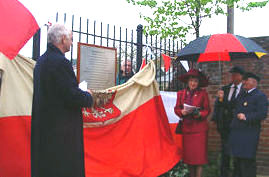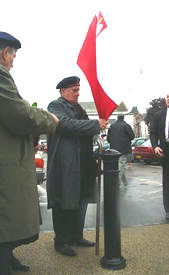| Back |
Cowes street named after Commander of ORP Blyskawica
 An
area in Cowes has been named after Commander Francki, the commanding officer
of ORP Blyskawica (Lightning), the Polish naval vessel which engaged
in action against Luftwaffe fighter-bombers which attacked Cowes in May 1942.
An
area in Cowes has been named after Commander Francki, the commanding officer
of ORP Blyskawica (Lightning), the Polish naval vessel which engaged
in action against Luftwaffe fighter-bombers which attacked Cowes in May 1942.
At a ceremony on May 3rd, 2004, Commander Francki's daughter, Nina
Doroszkowska, unveiled a special plaque
(warning this is a large image file which may take a while to download
on a standard 56k modem) which named the area outside the Painter's Arms Francki
Place and commemorated both the foresight of the Captain and the courage
of his crew. The ceremony was attended by the Mayor of Cowes, town Councillors,
relatives of Commodore Francki, and representatives of the IOW Polish Society
and the ORP Blyskawica Society.
The Blyskawica, a Grom class destroyer, was built by J.S.Whites & Co. in Cowes in 1935 and launched on October 1, 1936. From August 1939, just days before the German invasion of Poland, the Blyskawica and two sister ships were assigned to the Royal Navy for convoy protection duties. One of the fastest destroyers of her day, the Blyskawica was later assigned to escort the Queen Mary on troop carrying duties.
 The
Blyskawica, which had returned to Cowes for a refit, was anchored
near the chain ferry, on the night of May 4, 1942, when 160 low flying German
fighter-bombers attacked the town at about 11 pm. The crew of the Blyskawica
lit smoke screens in order to obscure the town and Free French naval units
stationed on the Medina opened fire with small calibre weapons. The mainstay
of the defence was the Blyskawica which used its heavy calibre guns
to force the enemy aircraft to fly too high for their bombing accuracy to
be guaranteed. More than 70 people were killed in Cowes, during two waves
of attacks on May 4/5 which lasted until daybreak.
The
Blyskawica, which had returned to Cowes for a refit, was anchored
near the chain ferry, on the night of May 4, 1942, when 160 low flying German
fighter-bombers attacked the town at about 11 pm. The crew of the Blyskawica
lit smoke screens in order to obscure the town and Free French naval units
stationed on the Medina opened fire with small calibre weapons. The mainstay
of the defence was the Blyskawica which used its heavy calibre guns
to force the enemy aircraft to fly too high for their bombing accuracy to
be guaranteed. More than 70 people were killed in Cowes, during two waves
of attacks on May 4/5 which lasted until daybreak.
After the war, the Blyskawica returned to Poland. Since
1976 she has served as a museum ship in the Gdynia dockyard in Poland. Several
Polish sailors from the Blyskawica settled in Cowes after the war.





